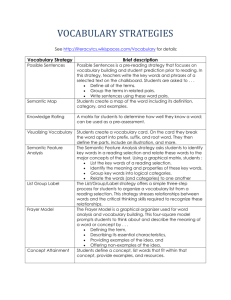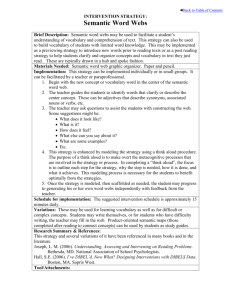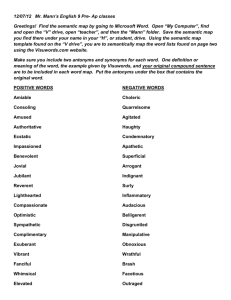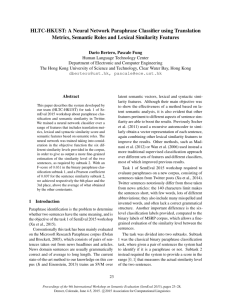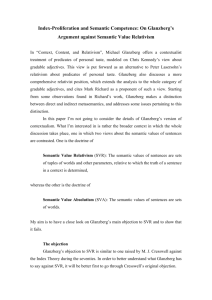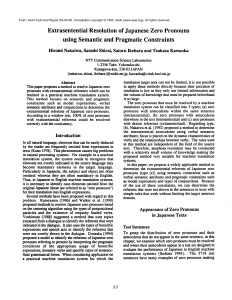Semantics
advertisement
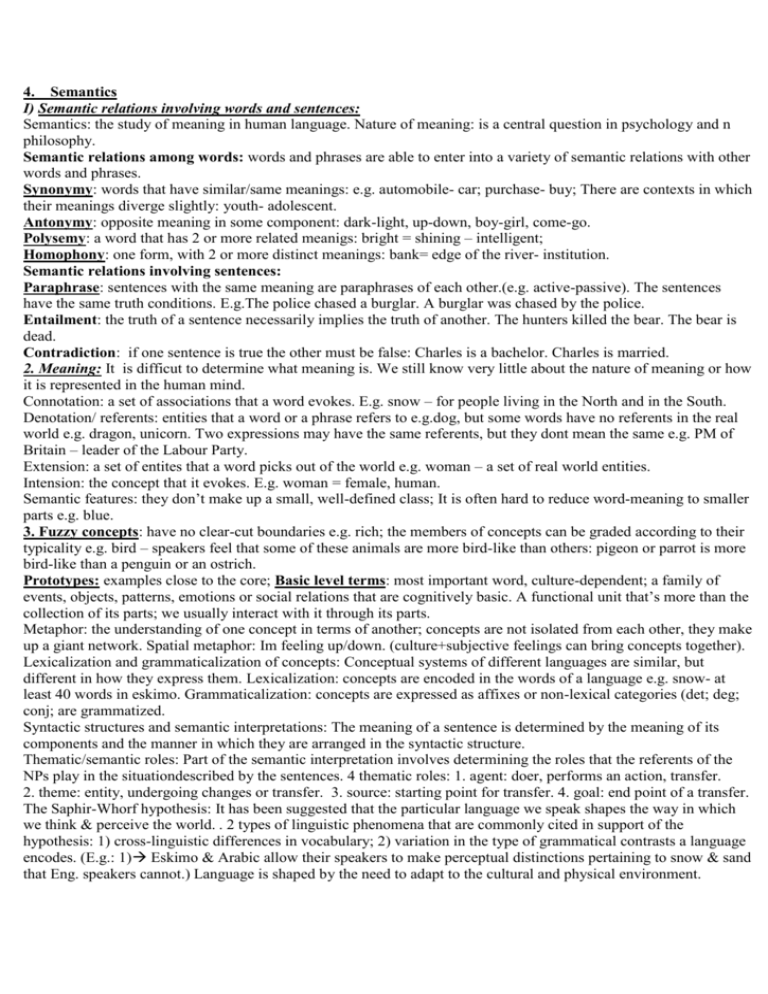
4. Semantics I) Semantic relations involving words and sentences: Semantics: the study of meaning in human language. Nature of meaning: is a central question in psychology and n philosophy. Semantic relations among words: words and phrases are able to enter into a variety of semantic relations with other words and phrases. Synonymy: words that have similar/same meanings: e.g. automobile- car; purchase- buy; There are contexts in which their meanings diverge slightly: youth- adolescent. Antonymy: opposite meaning in some component: dark-light, up-down, boy-girl, come-go. Polysemy: a word that has 2 or more related meanigs: bright = shining – intelligent; Homophony: one form, with 2 or more distinct meanings: bank= edge of the river- institution. Semantic relations involving sentences: Paraphrase: sentences with the same meaning are paraphrases of each other.(e.g. active-passive). The sentences have the same truth conditions. E.g.The police chased a burglar. A burglar was chased by the police. Entailment: the truth of a sentence necessarily implies the truth of another. The hunters killed the bear. The bear is dead. Contradiction: if one sentence is true the other must be false: Charles is a bachelor. Charles is married. 2. Meaning: It is difficut to determine what meaning is. We still know very little about the nature of meaning or how it is represented in the human mind. Connotation: a set of associations that a word evokes. E.g. snow – for people living in the North and in the South. Denotation/ referents: entities that a word or a phrase refers to e.g.dog, but some words have no referents in the real world e.g. dragon, unicorn. Two expressions may have the same referents, but they dont mean the same e.g. PM of Britain – leader of the Labour Party. Extension: a set of entites that a word picks out of the world e.g. woman – a set of real world entities. Intension: the concept that it evokes. E.g. woman = female, human. Semantic features: they don’t make up a small, well-defined class; It is often hard to reduce word-meaning to smaller parts e.g. blue. 3. Fuzzy concepts: have no clear-cut boundaries e.g. rich; the members of concepts can be graded according to their typicality e.g. bird – speakers feel that some of these animals are more bird-like than others: pigeon or parrot is more bird-like than a penguin or an ostrich. Prototypes: examples close to the core; Basic level terms: most important word, culture-dependent; a family of events, objects, patterns, emotions or social relations that are cognitively basic. A functional unit that’s more than the collection of its parts; we usually interact with it through its parts. Metaphor: the understanding of one concept in terms of another; concepts are not isolated from each other, they make up a giant network. Spatial metaphor: Im feeling up/down. (culture+subjective feelings can bring concepts together). Lexicalization and grammaticalization of concepts: Conceptual systems of different languages are similar, but different in how they express them. Lexicalization: concepts are encoded in the words of a language e.g. snow- at least 40 words in eskimo. Grammaticalization: concepts are expressed as affixes or non-lexical categories (det; deg; conj; are grammatized. Syntactic structures and semantic interpretations: The meaning of a sentence is determined by the meaning of its components and the manner in which they are arranged in the syntactic structure. Thematic/semantic roles: Part of the semantic interpretation involves determining the roles that the referents of the NPs play in the situationdescribed by the sentences. 4 thematic roles: 1. agent: doer, performs an action, transfer. 2. theme: entity, undergoing changes or transfer. 3. source: starting point for transfer. 4. goal: end point of a transfer. The Saphir-Whorf hypothesis: It has been suggested that the particular language we speak shapes the way in which we think & perceive the world. . 2 types of linguistic phenomena that are commonly cited in support of the hypothesis: 1) cross-linguistic differences in vocabulary; 2) variation in the type of grammatical contrasts a language encodes. (E.g.: 1) Eskimo & Arabic allow their speakers to make perceptual distinctions pertaining to snow & sand that Eng. speakers cannot.) Language is shaped by the need to adapt to the cultural and physical environment.

